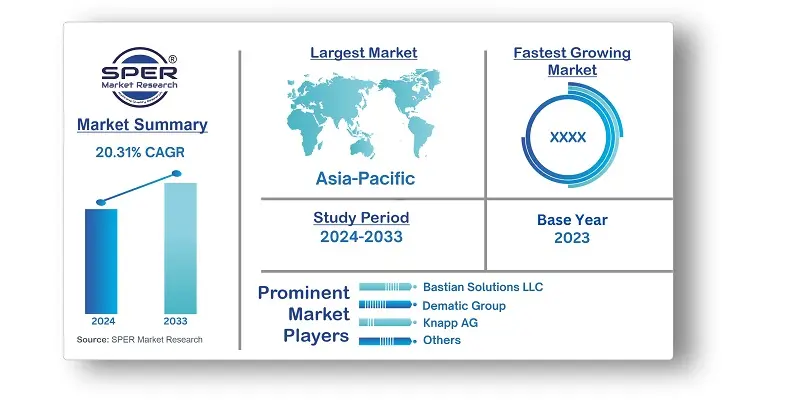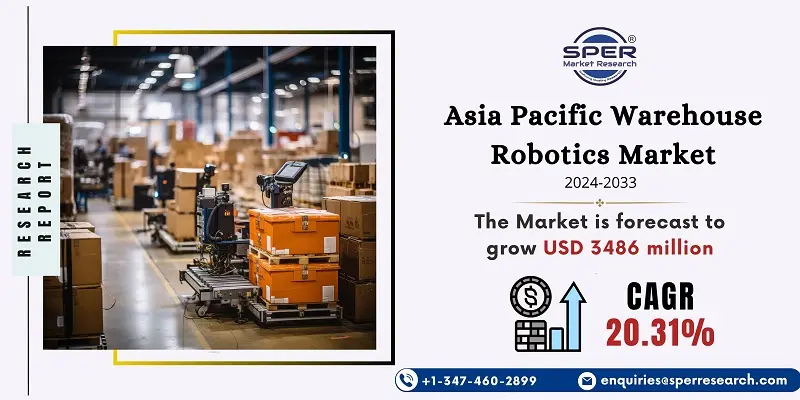
Asia Pacific Warehouse Robotics Market Growth, Size, Trends, Share, Demand and Future Outlook
Asia Pacific Warehouse Robotics Market Size- By Type, By Function, By Industry Vertical, Regional outlook, Competitive Strategies and Segment Forecast to 2033
| Published: Aug-2024 | Report ID: AMIN24180 | Pages: 1 - 156 | Formats*: |
| Category : Automotive & Transportation | |||
- April 2020; Yaskawa Sent off another multipurpose robot, Motoman-GP300R, another setup of rack-type robots that reinforces saving space in offices. It works downwards with a wide region where the impression is mounted, which makes it ideal for taking care of work from a higher place.
- January 2020; Singapore Innovations Designing cooperated with Aid rivers for independent vehicles. The two organizations marked a worldwide organization to team up on retrofitting central players with independent innovation.


| Report Metric | Details |
| Market size available for years | 2020-2033 |
| Base year considered | 2023 |
| Forecast period | 2024-2033 |
| Segments covered | By Type, By Function, By Industrial Vertical. |
| Regions covered | China, Japan, India, South Korea, Indonesia, Thailand, Vietnam, Australia & New Zealand, Rest of Asia-pacific. |
| Companies Covered | ABB Ltd, Bastian Solutions LLC, Daifuku Co. Limited, Dematic Group, Fetch Robotics Inc., Honeywell International Inc., Knapp AG, Kuka AG, Omron Corporation and Yaskawa Electric Corporation. |
- E-commerce and Retail Sector
- Manufacturing and Automotive Industry
- Food and Beverage Industry
- Pharmaceuticals and Healthcare Sector
- Logistics and Distribution Companies
| By Type: |
|
| By Function: |
|
| By Industry Vertical: |
|
- Asia Pacific Warehouse Robotics Market Size (FY’2024-FY’2033)
- Overview of Asia Pacific Warehouse Robotics Market
- Segmentation of Asia Pacific Warehouse Robotics Market by Type (mobile robots, automated guided vehicles, automated mobile robots, articulated robots, cylindrical robots, scara robots, parallel robots, cartesian robots.)
- Segmentation of Asia Pacific Warehouse Robotics Market by Function (pick & place, assembling-dissembling, transportation, packaging)
- Segmentation of Asia Pacific Warehouse Robotics Market by Industrial Vertical (e-commerce, automotive, electrical & electronics, metal and machinery, chemical, rubber & plastics, food & beverage, pharmaceuticals, other industry verticals)
- Statistical Snap of Asia Pacific Warehouse Robotics Market
- Expansion Analysis of Asia Pacific Warehouse Robotics Market
- Problems and Obstacles in Asia Pacific Warehouse Robotics Market
- Competitive Landscape in the Asia Pacific Warehouse Robotics Market
- Impact of COVID-19 and Demonetization on Asia Pacific Warehouse Robotics Market
- Details on Current Investment in Asia Pacific Warehouse Robotics Market
- Competitive Analysis of Asia Pacific Warehouse Robotics Market
- Prominent Players in the Asia Pacific Warehouse Robotics Market
- SWOT Analysis of Asia Pacific Warehouse Robotics Market
- Asia Pacific Warehouse Robotics Market Future Outlook and Projections (FY’2024-FY’2033)
- Recommendations from Analyst
1.1. Scope of the report1.2. Market segment analysis
2.1. Research data Product of Transport
2.1.1. Secondary Data2.1.2. Primary Data2.1.3. SPER’s internal database2.1.4. Premium insight from KOL’s
2.2. Market size estimation
2.2.1. Top-down and Bottom-up approach
2.3. Data triangulation
4.1. Driver, Restraint, Opportunity and Challenges analysis
4.1.1. Drivers4.1.2. Restraints4.1.3. Opportunities4.1.4. Challenges
4.2. COVID-19 Impacts of the Asia Pacific Warehouse Robotics Market
5.1. SWOT Analysis
5.1.1. Strengths5.1.2. Weaknesses5.1.3. Opportunities5.1.4. Threats
5.2. PESTEL Analysis
5.2.1. Political Landscape5.2.2. Economic Landscape5.2.3. Social Landscape5.2.4. Technological Landscape5.2.5. Environmental Landscape5.2.6. Legal Landscape
5.3. PORTER’s Five Forces
5.3.1. Bargaining power of suppliers5.3.2. Bargaining power of buyers5.3.3. Threat of Substitute5.3.4. Threat of new entrant5.3.5. Competitive rivalry
5.4. Heat Map Analysis
6.1. Asia Pacific Warehouse Robotics Market Manufacturing Base Distribution, Sales Area, Product Type6.2. Mergers & Acquisitions, Partnerships, Product Launch, and Collaboration in Asia Pacific Warehouse Robotics Market
7.1. Asia Pacific Warehouse Robotics Market, Share and Forecast, By Type, 2020-20267.2. Asia Pacific Warehouse Robotics Market, Share and Forecast, By Type, 2027-20337.3. Mobile robots7.4. Automated guided vehicles7.5. Automated mobile robots7.6. Articulated robots7.7. Cylindrical robots7.8. Scara robots7.9. Parallel robots7.10. Cartesian robots.
8.1. Asia Pacific Warehouse Robotics Market, Share and Forecast, By Function, 2020-20268.2. Asia Pacific Warehouse Robotics Market, Share and Forecast, By Function, 2027-20338.3. Pick & place8.4. Assembling-dissembling8.5. Transportation8.6. Packaging
9.1. Asia Pacific Warehouse Robotics Market, Share and Forecast, By Industry Vertical, 2020-20269.2. Asia Pacific Warehouse Robotics Market, Share and Forecast, By Industry Vertical, 2027-20339.3. E-commerce9.4. Automotive9.5. Electrical & Electronics9.6. Metal and Machinery9.7. Chemical9.8. Rubber & Plastics9.9. Food & Beverage9.10. Pharmaceuticals9.11. Other industry verticals
10.1. Asia Pacific Warehouse Robotics Market and Market Share
11.1. Asia Pacific Warehouse Robotics Market and Market Share By Region (2020-2026)11.2. Asia Pacific Warehouse Robotics Market and Market Share By Region (2027-2033)11.3. China11.4. Japan11.5. India11.6. South Korea11.7. Indonesia11.8. Thailand11.9. Vietnam11.10. Australia & New Zealand11.11. Rest of Asia-pacific
12.1. ABB Ltd
12.1.1. Company details12.1.2. Financial outlook12.1.3. Product summary12.1.4. Recent developments
12.2. Bastian Solutions LLC
12.2.1. Company details12.2.2. Financial outlook12.2.3. Product summary12.2.4. Recent developments
12.3. Daifuku Co.
12.3.1. Company details12.3.2. Financial outlook12.3.3. Product summary12.3.4. Recent developments
12.4. Dematic Group
12.4.1. Company details12.4.2. Financial outlook12.4.3. Product summary12.4.4. Recent developments
12.5. Fetch Robotics, Inc.
12.5.1. Company details12.5.2. Financial outlook12.5.3. Product summary12.5.4. Recent developments
12.6. Honeywell International, Inc.
12.6.1. Company details12.6.2. Financial outlook12.6.3. Product summary12.6.4. Recent developments
12.7. Knapp AG
12.7.1. Company details12.7.2. Financial outlook12.7.3. Product summary12.7.4. Recent developments
12.8. Kuka AG
12.8.1. Company details12.8.2. Financial outlook12.8.3. Product summary12.8.4. Recent developments
12.9. Omron Corporation
12.9.1. Company details12.9.2. Financial outlook12.9.3. Product summary12.9.4. Recent developments
12.10. Yaskawa Electric Corporation
12.10.1. Company details12.10.2. Financial outlook12.10.3. Product summary12.10.4. Recent developments
12.11. Others
SPER Market Research’s methodology uses great emphasis on primary research to ensure that the market intelligence insights are up to date, reliable and accurate. Primary interviews are done with players involved in each phase of a supply chain to analyze the market forecasting. The secondary research method is used to help you fully understand how the future markets and the spending patterns look likes.
The report is based on in-depth qualitative and quantitative analysis of the Product Market. The quantitative analysis involves the application of various projection and sampling techniques. The qualitative analysis involves primary interviews, surveys, and vendor briefings. The data gathered as a result of these processes are validated through experts opinion. Our research methodology entails an ideal mixture of primary and secondary initiatives.



Frequently Asked Questions About This Report
PLACE AN ORDER
Year End Discount
Sample Report
Pre-Purchase Inquiry
NEED CUSTOMIZATION?
Request CustomizationCALL OR EMAIL US
100% Secure Payment






Related Reports
Our Global Clients
Our data-driven insights have influenced the strategy of 200+ reputed companies across the globe.




















